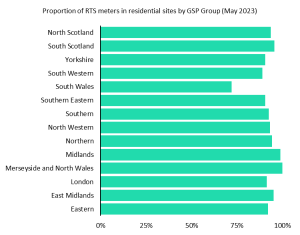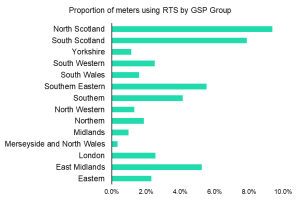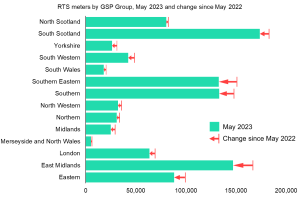Where are Great Britain’s Radio Teleswitch System meters and who uses them?
This is the second in our series of articles that provide statistics and information on Radio Teleswitch System (RTS) meters. Since April 2020 the costs for the RTS service have been recovered through the Balancing and Settlement Code (BSC) charging arrangements.
Elexon’s data on RTS meters
Elexon collects data on active meters through the Supplier Volume Allocation Agent (SVAA), including counts of meters broken down by various characteristics such as profile class and Time Pattern Regime, which indicates if a meter’s activity changes over time such as non-recording time or tariff switching. These can be used to identify meters using the Radio Teleswitch System as well as those at residential sites. The SVAA is a BSC system which aggregates profiled and actual readings from meters so that it can calculate and attribute half hourly consumption for each Supplier. This does not include non-meter systems which may be using the RTS for timing such as hot water tanks.
Which areas in the country have the most RTS meters?
Elexon splits GB into 14 Grid Supply Point Groups, broadly corresponding with geographical regions of the country. The metering data we collect can be used to estimate the numbers of RTS meters in the country, split by the GSP Groups. The proportion of total meters in each group accounted for by RTS meters varies widely between different parts of the country.
In May 2023, the share of meters using RTS was greatest in Scotland, with 8-9% of meters being RTS. The lowest proportion was in Merseyside and North Wales with only 0.3% of meters using RTS.
The rate at which RTS meters are decommissioned (replaced with smart meters) varies from region to region. The number of RTS meters in Yorkshire and Midlands decreased by 15% and 14% respectively between May 2022 and May 2023, while the numbers of meters in Northern and Southern Scotland declined by 2% and 5%.
Vast majority of RTS meters are in households
RTS meters are predominantly found in residential properties (more than 90% of the time in most areas) although the proportion varies from 72% in South Wales to 100% in Merseyside and North Wales.
What’s next?
The deadline for the signal to be switched off is currently set for March 2024.
This concludes our series of articles on RTS meters. Data on the number of RTS meters remaining in service will continue to be available through our monthly Trading Operations Report and we will continue to monitor the situation as it progresses.
See more information about the switch off in my previous article.



